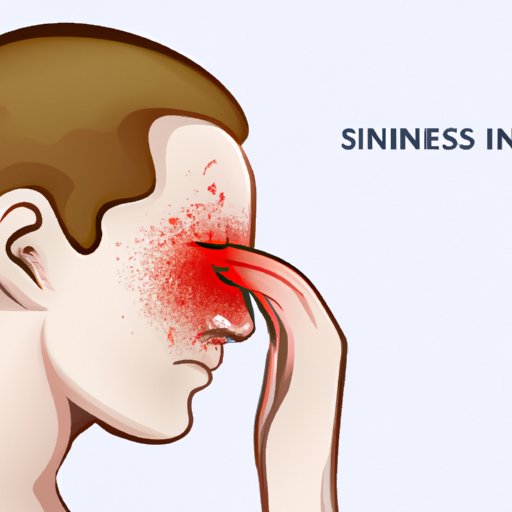
Introduction
Sinus infections, also known as sinusitis, is a common condition that affects millions of people each year. It is caused by inflammation of the sinuses due to an infection, allergy or autoimmune reaction. If you’ve ever experienced a sinus infection, you know how uncomfortable and debilitating it can be. In this article, we’ll discuss the most common symptoms of sinus infections, how to identify them, and what you can do to alleviate them.
10 Symptoms of Sinus Infection You Need to Look Out For
The following are the ten most common symptoms of a sinus infection:
- Facial pain and pressure
- Nasal congestion
- Headache
- Loss of smell or taste
- Cough
- Fever
- Fatigue
- Toothache
- Sore throat
- Bad breath
Each of these symptoms can vary in intensity depending on the severity of the sinus infection.
Facial pain and pressure: Sinusitis can cause pain and pressure around the eyes, forehead, and cheeks. This is due to inflammation and swelling of the sinuses.
Nasal congestion: A stuffy or congested nose is a common symptom of sinusitis. The swelling of the nasal passages can make it difficult to breathe and cause discomfort.
Headache: Sinus headaches are often described as a dull, throbbing pain that is felt around the eyes, forehead, and cheeks.
Loss of smell or taste: Inflammation of the sinuses can affect your sense of smell and taste.
Cough: A cough is a common symptom of sinusitis, particularly if you have postnasal drip.
Fever: A low-grade fever may be present in some cases of sinusitis.
Fatigue: Sinusitis can make you feel tired and run down.
Toothache: Inflammation of the sinuses can cause pain in the upper teeth.
Sore throat: A sore throat can be a symptom of sinusitis if postnasal drip irritates the throat.
Bad breath: Sinusitis can cause halitosis or bad breath.
If you are experiencing any of these symptoms, it’s important to take action to alleviate them.
Is It a Cold or A Sinus Infection? How to Identify the Symptoms
Cold and sinus infections share many symptoms, which can make it difficult to identify which one you have. The following are some indicators that you may have a sinus infection:
- Symptoms lasting more than 10 days
- Facial pain and pressure
- Green or yellow nasal discharge
- Fever
- Postnasal drip
- Loss of smell or taste
While a cold typically lasts around a week and gets progressively better over time, sinusitis symptoms can last for weeks or even months if left untreated. If you are experiencing any of these symptoms, it’s important to seek medical attention.
From Congestion to Headache: Understanding Sinus Infection Symptoms
Sinus infection symptoms are primarily caused by inflammation and swelling of the sinuses. The following are the most common symptoms:
Nasal congestion: When the sinuses become inflamed, they produce excess mucus that can clog the nasal passages.
Facial pain and pressure: Inflammation and swelling can put pressure on the nerves and blood vessels in the face, causing pain and discomfort.
Headache: Sinus headaches are caused by pressure and inflammation in the sinuses. The pain can range from mild to severe.
Cough: Postnasal drip caused by excessive mucus production can lead to a cough that is often worse at night.
Fever: In some cases, sinus infections can cause a low-grade fever.
Fatigue: Sinusitis can make you feel tired and run-down due to the body’s immune response to the infection.
Bad breath: Excess mucus and inflammation in the sinuses can lead to halitosis or bad breath.
Fortunately, there are several ways to alleviate these symptoms and speed up the healing process.
Sinus Infection Symptoms: What You Need to Tell Your Doctor
While many sinus infections can be treated at home, it’s important to seek medical attention if you are experiencing any of the following symptoms:
- Fever over 101°F
- Severe headache or facial pain
- Swelling around the eyes
- Stiff neck or shortness of breath
Your doctor may prescribe antibiotics or other medications to speed up the healing process. In some cases, surgery may be necessary to treat chronic sinusitis.
The Lesser-Known Symptoms of Sinus Infections You’ve Been Ignoring
In addition to the common symptoms, sinus infections can cause a number of lesser-known symptoms that are often overlooked. These can include:
- Ear pain
- Nausea and vomiting
- Jaw pain
- Eye pain or vision problems
- Dizziness
If you are experiencing any of these symptoms, it’s important to seek medical attention right away.
Sinus Infection Symptoms: When to Seek Medical Attention
Sinus infections can be serious and even life-threatening in certain situations. Seek immediate medical attention if you experience any of the following symptoms:
- Severe headache or facial pain
- High fever (over 102°F)
- Stiff neck or seizures
- Confusion or difficulty breathing
These symptoms may indicate a more serious condition such as meningitis or an abscess in the brain.
Sinus Infection 101: Everything You Need to Know About Its Symptoms
Sinus infections are a common condition that can cause a range of uncomfortable symptoms. To alleviate these symptoms, try the following:
- Drink plenty of fluids to thin out mucus
- Use a humidifier or steam inhalation to moisten the nasal passages
- Use over-the-counter saline nasal sprays to flush out mucus
- Take pain relievers such as acetaminophen or ibuprofen
- Avoid irritants such as tobacco smoke and alcohol
Remember, if you are experiencing severe or persistent symptoms, seek medical attention right away.
Conclusion
Sinus infections can cause a range of uncomfortable symptoms that can last for weeks or even months. It’s important to take action to alleviate these symptoms and seek medical attention if necessary. Remember to drink plenty of fluids, use a humidifier or steam inhalation, and avoid irritants. With proper care and attention, you can alleviate your symptoms and get back to your daily routine.




